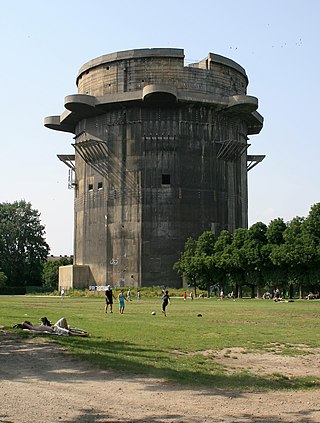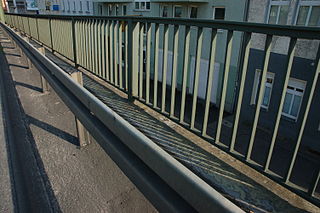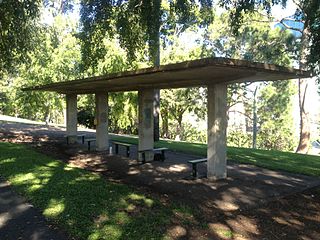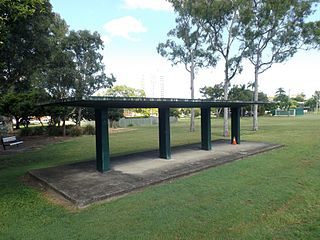
A blast wall is a barrier designed to protect vulnerable buildings or other structures and the people inside them from the effects of a nearby explosion, whether caused by industrial accident, military action, or terrorism.

A blast wall is a barrier designed to protect vulnerable buildings or other structures and the people inside them from the effects of a nearby explosion, whether caused by industrial accident, military action, or terrorism.
Research by Cranfield University Defence Academy, building on earlier work, has shown that blast walls have the following properties:

Permanent blast walls can be made from pre-cast reinforced concrete, [4] or steel sheeting. [5] Various types of moveable blast wall have been manufactured. These include the Bremer wall concrete barriers used in Iraq and Afghanistan by US Armed Forces, and the Concertainers, wire mesh containers filled with sand or soil, which are used by British Armed Forces.

A firewall is a fire-resistant barrier used to prevent the spread of fire. Firewalls are built between or through buildings, structures, or electrical substation transformers, or within an aircraft or vehicle.
A neutron bomb, officially defined as a type of enhanced radiation weapon (ERW), is a low-yield thermonuclear weapon designed to maximize lethal neutron radiation in the immediate vicinity of the blast while minimizing the physical power of the blast itself. The neutron release generated by a nuclear fusion reaction is intentionally allowed to escape the weapon, rather than being absorbed by its other components. The neutron burst, which is used as the primary destructive action of the warhead, is able to penetrate enemy armor more effectively than a conventional warhead, thus making it more lethal as a tactical weapon.

A bunker is a defensive military fortification designed to protect people and valued materials from falling bombs, artillery, or other attacks. Bunkers are almost always underground, in contrast to blockhouses which are mostly above ground. They were used extensively in World War I, World War II, and the Cold War for weapons facilities, command and control centers, and storage facilities. Bunkers can also be used as protection from tornadoes.

The effects of a nuclear explosion on its immediate vicinity are typically much more destructive and multifaceted than those caused by conventional explosives. In most cases, the energy released from a nuclear weapon detonated within the lower atmosphere can be approximately divided into four basic categories:

Air raid shelters are structures for the protection of non-combatants as well as combatants against enemy attacks from the air. They are similar to bunkers in many regards, although they are not designed to defend against ground attack.

"Duck and cover" is a method of personal protection against the effects of a nuclear explosion. Ducking and covering is useful in offering a degree of protection to personnel located outside the radius of the nuclear fireball but still within sufficient range of the nuclear explosion that standing upright and uncovered is likely to cause serious injury or death. In the most literal interpretation, the focus of the maneuver is primarily on protective actions one can take during the first few crucial seconds-to-minutes after the event, while the film of the same name and a full encompassing of the advice also cater to providing protection up to weeks after the event.

A seawall is a form of coastal defense constructed where the sea, and associated coastal processes, impact directly upon the landforms of the coast. The purpose of a seawall is to protect areas of human habitation, conservation, and leisure activities from the action of tides, waves, or tsunamis. As a seawall is a static feature it will conflict with the dynamic nature of the coast and impede the exchange of sediment between land and sea.

A blast shelter is a place where people can go to protect themselves from blasts and explosions, like those from bombs, or in hazardous worksites, such as on oil and gas refineries or petrochemical facilities. It differs from a fallout shelter, in that its main purpose is to protect from shock waves and overpressure instead of from radioactive precipitation, as a fallout shelter does. It is also possible for a shelter to protect from both blasts and fallout.
In fluid dynamics, a blast wave is the increased pressure and flow resulting from the deposition of a large amount of energy in a small, very localised volume. The flow field can be approximated as a lead shock wave, followed by a self-similar subsonic flow field. In simpler terms, a blast wave is an area of pressure expanding supersonically outward from an explosive core. It has a leading shock front of compressed gases. The blast wave is followed by a blast wind of negative gauge pressure, which sucks items back in towards the center. The blast wave is harmful especially when one is very close to the center or at a location of constructive interference. High explosives that detonate generate blast waves.

Traffic barriers keep vehicles within their roadway and prevent them from colliding with dangerous obstacles such as boulders, sign supports, trees, bridge abutments, buildings, walls, and large storm drains, or from traversing steep (non-recoverable) slopes or entering deep water. They are also installed within medians of divided highways to prevent errant vehicles from entering the opposing carriageway of traffic and help to reduce head-on collisions. Some of these barriers, designed to be struck from either side, are called median barriers. Traffic barriers can also be used to protect vulnerable areas like school yards, pedestrian zones, and fuel tanks from errant vehicles.

The Concertainer, known colloquially as the Hesco barrier, or Hesco bastion, is a modern gabion primarily used for flood control and military fortifications. It is made of a collapsible wire mesh container and heavy duty fabric liner, and used as a temporary to semi-permanent levee or blast wall against small-arms fire and/or explosives. It has seen considerable use during the War on terror in Iraq and Afghanistan.

A Bremer wall, or T-wall, is a twelve-foot-tall (3.66 m) portable, steel-reinforced concrete blast wall of the type used for blast protection throughout Iraq and Afghanistan.

Newstead Air Raid Shelter is a heritage-listed former air raid shelter at Commercial Road, Teneriffe, City of Brisbane, Queensland, Australia. It was designed by Frank Gibson Costello and built c. 1942 by the Brisbane City Council. It was added to the Queensland Heritage Register on 6 April 2005.

Morningside Air Raid Shelter is a heritage-listed former air raid shelter at 580 Wynnum Road, Morningside, Queensland, Australia. It was designed by Frank Gibson Costello and built c. 1942 by Brisbane City Council. It was added to the Queensland Heritage Register on 6 April 2005.

Raymond Park (West) Air Raid Shelter is a heritage-listed former air raid shelter in Raymond Park at 94 Baines Street, Kangaroo Point, Queensland, Australia. It was designed by Frank Gibson Costello and built c. 1942 by Brisbane City Council. It was added to the Queensland Heritage Register on 6 April 2005.

Raymond Park (East) Air Raid Shelter is a heritage-listed former air raid shelter in Raymond Park at 184 Wellington Road, Kangaroo Point, Queensland, Australia. It was designed by Frank Gibson Costello and built c. 1942 by Brisbane City Council. It was added to the Queensland Heritage Register on 6 April 2005.

Hefferan Park Air Raid Shelter is a heritage-listed former air raid shelter at 260 Annerley Road, Annerley, City of Brisbane, Queensland, Australia. It was designed by Frank Gibson Costello and built in c. 1942 by the Brisbane City Council. It was added to the Queensland Heritage Register on 6 April 2005.

Stones Corner Air Raid Shelter is a heritage-listed former air raid shelter at 286 Logan Road, Stones Corner, City of Brisbane, Queensland, Australia. It was designed by Frank Gibson Costello and built c. 1942 by Brisbane City Council. It was added to the Queensland Heritage Register on 6 April 2005.

Albert Park (North) air raid shelter is a heritage-listed former air raid shelter at Albert Park, Wickham Terrace, Spring Hill, City of Brisbane, Queensland, Australia. It was designed by Frank Gibson Costello and built c. 1942 by Brisbane City Council. It was added to the Queensland Heritage Register on 31 May 2005.
Termite barriers are materials that have been specifically designed to prevent subterranean termites from gaining access to a structure. Physical termite barriers are free of pesticides and physically block termite foraging activity. Development of physical barriers to effectively exclude subterranean termites makes it possible to design and build structures with a far lower possibility of termite invasion and damage over the life of the building. Because of their small size, impressive reproductive capability, and ability to eat through many construction materials, termites are the most destructive of all insects.
![]() Media related to Blast barriers at Wikimedia Commons
Media related to Blast barriers at Wikimedia Commons